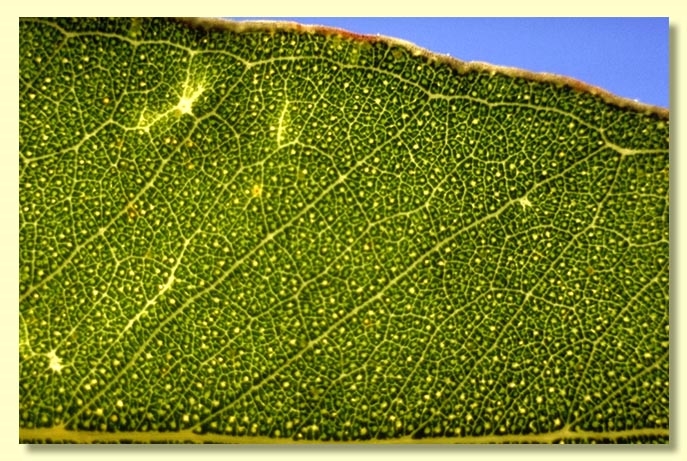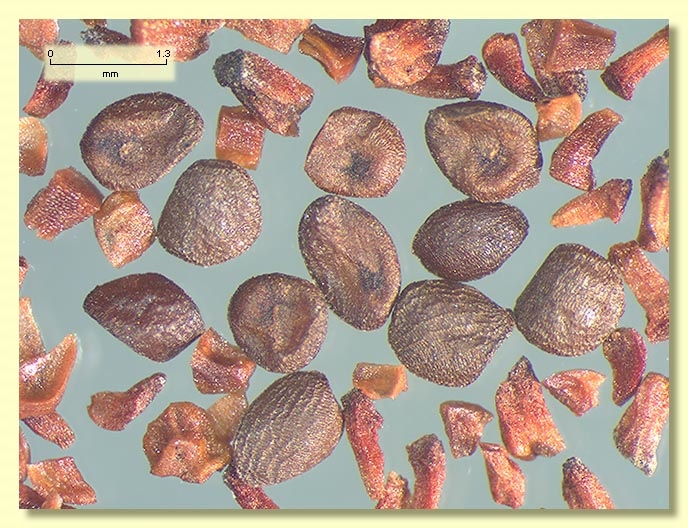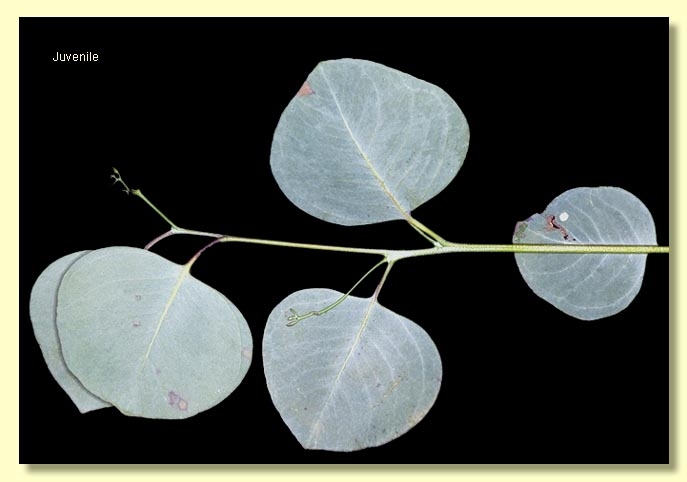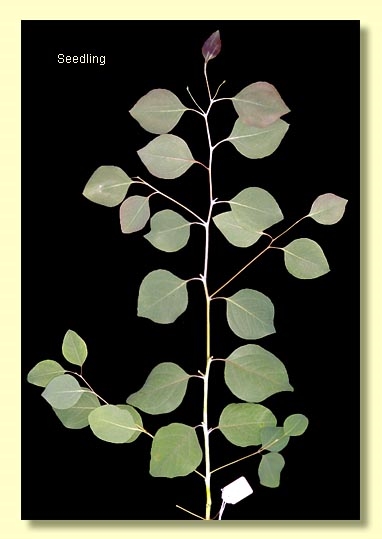Euclid - Online edition
Eucalyptus magnificata
Eucalyptus | Symphyomyrtus | Adnataria | Terminales | Heterophloiae
T: New South Wales: Northern Tablelands: Enmore, 18 miles [29 km] E of Uralla, 18 Mar. 1917, R.H.Cambage 3776 : NSW.
Bark rough on trunk and larger branches, shortly fibrous or box-type, thin and flaky, grey and grey-brown smooth bark coppery, brown, grey-green, or grey. Branchlets are rarely glaucous.
Juvenile growth (coppice or field seedlings to 50 cm): stem rounded in cross-section, glaucous or non-glaucous; juvenile leaves always petiolate, opposite for 5 or 6 nodes then alternate, orbicular to ovate, 3.5–8 cm long, 3.5–6.5 cm wide, base rounded or truncate, apex broadly pointed to rounded or emarginate, margin usually entire, green to blue-green or glaucous.
Adult leaves alternate, petiole 1–3 cm long; blade broadly lanceolate to ovate or elliptical, (3.3)5–15 cm long, 3–6.5 cm wide, flat or undulate, base tapering to petiole, apex broadly pointed or emarginate, concolorous, dull or glossy, green to blue-green, rarely slightly glaucous, side-veins greater than 45° to midrib, densely to very densely reticulate, intramarginal vein parallel to and well removed from margin and looped, oil glands island and intersectional.
Inflorescence terminal compound, sometimes axillary unbranched or axillary compound (in subterminal axils), peduncles 0.5–1.3 cm long, buds 7 per umbel, pedicels 0.1–0.6 cm long. Mature buds obovoid, ca 0.5 cm long, 0.3–0.5 cm wide, glaucous or red to green, scar present (outer operculum shed early), inner operculum conical to beaked, stamens inflexed, outer filaments lack anthers (staminodes), anthers adnate, basally attached and positioned obliquely at filament tip, cuboid, dehiscing by terminal pores, style long, stigma blunt or pin-head shaped, locules usually 3, the placentae each with 4 vertical ovule rows. Flowers white, or pale yellow to lemon.
Fruit on pedicels 0.1–0.6 cm long, obconical, 0.5–0.9 cm long, 0.5–0.9 cm wide, glaucous or non-glaucous, rim thin, often splitting, disc descending, valves 3 or 4, enclosed.
Seeds brown, 0.8–2 mm long, ovoid or flattened-ovoid, dorsal surface pitted, hilum ventral.
Cultivated seedlings (measured at ca node 10): cotyledons reniform to oblong; stems rounded in cross-section; leaves always petiolate, opposite for 4 or 5 nodes then alternate, ovate to orbicular, 4–6 cm long, 4.5–6.5 cm wide, base truncate to tapering, margin entire, apex rounded to emarginate, green.
Flowering has been recorded in June and November.
A small tree or mallee occurring on clayey soils, known only from Hillgrove and Enmore, south-east of Armidale in the central part of the Northern Tablelands of New South Wales, and from the Stanthorpe district of south-east Queensland. It is a box-barked tree of small form, with slightly glossy, blue-green, ovate adult leaves, terminal inflorescence with variably glaucous buds with the conical operculum narrower than the basal part of the bud, and obconical fruit with 3 or 4 valves and a ragged or split rim.
Its nearest relative is the more southerly species valleys of sub-coastal hill country, E. baueriana, which has smaller buds and fruit but with some overlap in dimensions (fruit 0.4-0.7 cm wide in E. baueriana and 0.5-0.9 cm wide in E. magnificata ). Other box species with distribution overlapping that of E. magnificata are: E. conica, which differs in having ovate juvenile and lanceolate adult leaves and smaller obconical fruit, and E. melliodora, which has axillary, not terminal, inflorescences and hemispherical to truncate-globose fruit. Another close relative of E. magnificata is E. polyanthemos which has fruit more barrel-shaped tending to obconical and 0.3-0.6 cm wide.
Eucalyptus magnificata belongs in Eucalyptus subgenus Symphyomyrtus section Adnataria because the buds have two opercula, ovules are in four rows, seeds are flattened-ovoid, cotyledons are reniform, and anthers are rigid on the staminal filaments. Within section Adnataria, E. magnificata is part of series Heterophloiae having box bark, terminal inflorescences, buds that shed the outer operculum early, stamens inflexed and the outer stamens sterile (staminodes). Other species in this series are E. rudderi from the Taree area of the North Coast of New South Wales, E. baueriana and E. polyanthemos in southern New South Wales and eastern Victoria, E. hypostomatica north from western Sydney to Wattagan State Forest, E. conica from the slopes and adjacent tableland areas of New South Wales north from the Weddin Mountains to central Queensland, and E. fasciculosa from far western Victoria and south-eastern parts of South Australia. An eighth species in the series, E. lucens, is found only west and south-west of Alice Springs.













